GLACIAL MAN IN OHIO.
By PROF. , D. D., LL. D.
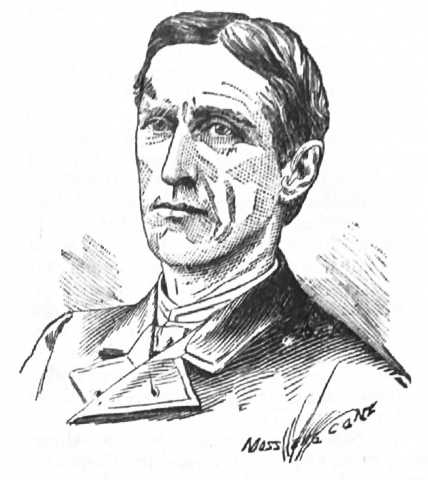
George Frederick Wright was born at Whitehall, N. Y., January 22, 1838; graduated at Oberlin College, 1859, and Theological Seminary, Oberlin, O., 1882; was in the Seventh Ohio Volunteer Infantry five months of 1860; became pastor at Bakersfield, Vt., 1862; at Andover, Mass., 1872; Professor of New Testament Language and Literature in Oberlin Theological Seminary, 1881; was assistant geologist on Pennsylvania survey, 1881, and United States survey since 1884. He is the author of “The Logic of Christian Evidences,” Andover, 1880, 4th ed. 1883; “Studies in Science and Religion,” 1882; “The Relation of Death to Probation,” Boston, 1882, 2d ed. 1883; “The Glacial Boundary in Ohio, Indiana and Kentucky,” Cleveland, 1884; “The Divine Authority of the Bible,” Boston, 1884; is an editor of the Bibliotheca Sacra.** The biography is taken from the “Encyclopedia of Living Divines and Christian Workers” (Supplement to Schaff-Herzog, “Encyclopaedia of Religious Knowledge”).
The earliest chapter in the history of man in Ohio begins with the close of the glacial period in the Mississippi valley. To understand this history it is necessary to devote a little time to the study of the glacial period. Nor will this be uninteresting to the thoughtful and observing citizens of the State, for the subject is one which is not far off, but near at hand. As will be seen by a glance at the accompanying map, all but the southeastern portion of the State is glaciated, that is, it is covered with the peculiar deposits and marks which show to the observant eye that the country was at one time deeply covered with a moving sheet of ice. These marks are open to the inspection of any one who will read as he runs. The tracks of a glacier can as readily be recognized as those of a horse or an elephant.
The glacier which in a far distant period invaded Ohio can be tracked by three signs: (1) Scratches on the bed rock; (2) “Till;” (3) Boulders. Taking these in their order, we notice (1) that scratches on the bed rock in such a level region as Ohio could not be produced by any other means than glacial ice, and that a glacier is entirely competent to produce them. When water runs over a rocky bed it ordinarily wears it off unevenly. A rocky surface is hardly ever of uniform hardness throughout, so that, as gravel-stones and pebbles are pushed over it by running water, they wear down the soft parts faster than the hard parts, and an uneven surface is produced. This follows from the fluidity of water, and any one can verify the statement by observing the bed of a shallow stream in dry weather. But ice is so nearly a solid that it holds with a firm grasp the sand, gravel and larger rocky fragments which happen to be frozen into its bottom ayer and shoves them along as a mechanic shoves a plane over a board or a graving tool over a surface of stone or metal. Thus the movement of a glacier produces on the surface of the rocks over which it moves a countless number of parallel lines of a size corresponding to that of the rocky fragment shoved along underneath it. A boulder shoved along underneath a glacier may plow a furrow, while fine sand would make but the most minute lines, but all in nearly the same direction. In short, the bottom of a glacier is a mighty rasp, or rather a combination of a plough, a rasp, a sand-paper and a pumice-stone, ploughing, scraping, scratching and polishing the surface all at the same time.
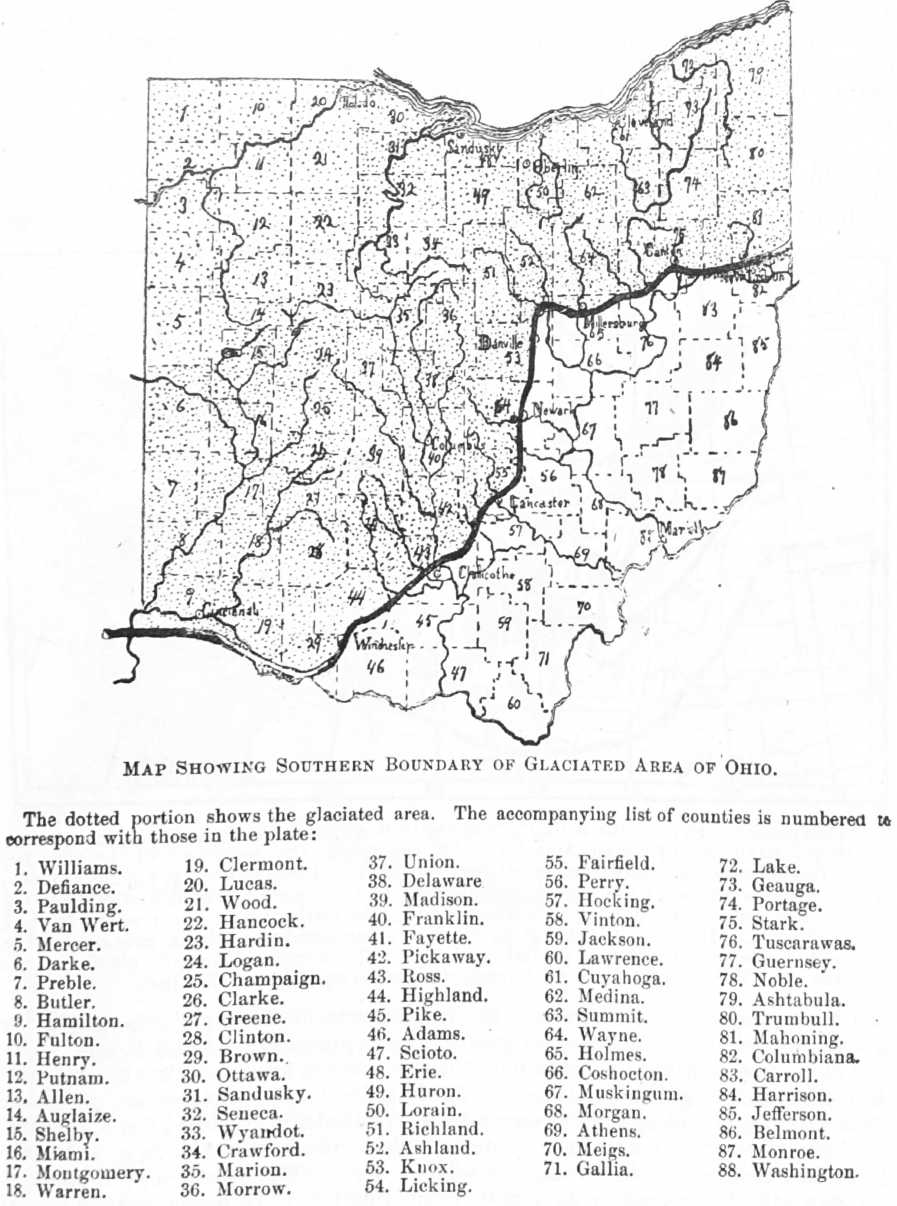
Now these phenomena, so characteristic of the areas just in front of a receding glacier, are very abundant in certain portions of Ohio. The most celebrated locality in the State, and perhaps in the world, is to be found in the islands near Sandusky. These islands consist of a hard limestone rock which stands the weather well, so that the glacial marks upon them are better preserved than in some other localities, and the ice-movement over them was longer continued and more powerful than in some other places. On Kelley’s Island may be seen furrows several inches and sometimes two feet deep, running for many rods in one direction. Whole acres when freshly uncovered are seen to be fluted by the parallel lines of these furrows, the whole surface being polished and scoured by the finer material shoved along in company with the larger fragments. The direction of these furrows and scratches is mainly a little south of west, or nearly that of the longest diameter of the lake itself, showing that for a time the ice moved in that direction.
But the greater part of Ohio is several hundred feet higher than Lake Erie, and yet similar glacial scratches are to be found all over the higher land to some distance south of the water-shed, and in the western part of the state clear down to the Ohio River. On this higher land the direction of the scratches is south and southeast, showing that there was an ice movement during the height of the glacial period which entirely disregarded the depression of Lake Erie.
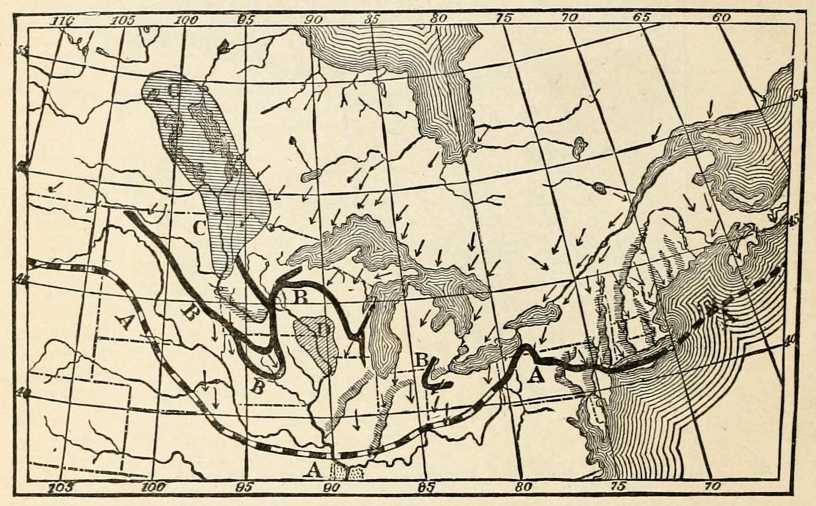
The most southern points where these scratches are found in the State are in Butler and Highland counties. In Highland county they are abundant near Lexington and in Butler county near Woodsdale. Many of the counties in the northwestern part of the State are so deeply covered with soil that the scratched surfaces of their rocks are seldom seen. The northeastern counties are more thinly covered, or have more projecting ledges of rocks, so that glacial grooving and scratches are more easily found and have been more frequently observed there.
(2) The “till” of which we have spoken consists of the loose soil which in the glaciated region covers the bed rock. In places this is of great depth, and everywhere it has a peculiar composition. Outside of the glaciated region the soil is formed by the gradual disintegration or rotting of the rocks from their surface downwards, so that, except along streams, there is then no soil but such as is derived from the rocks of the immediate vicinity. In a limestone region the soil will have all come from the dissolution of limestone, in a sandstone region from the disintegration of sandstone, and in a slatestone region from the weathering of that rock. But over a glaciated region the soil will be found to be composed of a variety of elements derived from various places in the direction from which the ice movement came. Thus in Stark, Holmes, Knox, Licking and Fairfield counties the soil will be found to be composed of a mixture of granitic fragments which have been brought all the way from Canada, limestone dug out from the bed of Lake Erie, shale gathered from the counties to the north and west, and sandstone ground up from the immediate vicinity. And these materials are not in separate layers, as when deposited by water, but are as thoroughly mixed as mortar in a hod.
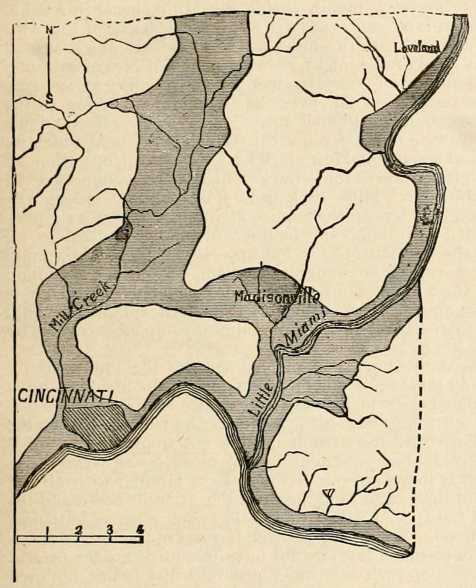
The space covered by horizontal lines is occupied by preglacial valleys, filled to a height of 100 to 200 feet above the Ohio river with modified drift. The unlined portion consists of the tableland from 200 to 500 feet above the river.
The only way in which materials could be thus collected in such situations and thus thoroughly mixed is by ice action. The ice of the glacial period as it moved over the rough surfaces to the north ground off the prominences and filled up the gorges and hollows, and we have in this unstratified mixture, denominated “till,” what Professor Newbery called the grist of the glacier. The extent of this deposit in Ohio is enormous. In St. Paris, Champaign county, the till was penetrated more than 500 feet without finding the bed rock. This was doubtless in the filled-up gorge of a pre-glacial watercourse, of which there are a great many in the State. But the average depth of the till over the glaciated part of the State, as shown by the facts Professor Orton has gathered from the wells recently bored for gas, is nearly 100 feet.
(3.) The boulders, most characteristic of the glaciated region of Ohio, are granitic. These are variously known in different localities as boulders, hard heads and “nigger heads,” and have all been brought from a great distance, and so are common, not only to the glaciated region of Ohio, but to the whole glaciated region of the States east and west of it. The granitic mountains from which these boulders must have been derived run from the northern part of New York, where they constitute the Adirondacks, through Canada to the northern shore of Lake Huron and extend westward along the south shore of Lake Superior, containing the celebrated mining districts of that region. Boulders from this range of mountains are scattered all over the region which was glaciated. They are found in great abundance in the hills of Northwestern Pennsylvania, and everywhere down to the glacial line as marked in the accompanying map of Ohio. One near Lancaster is eighteen feet and about twelve feet wide and six feet out of ground. This must have been brought 500 miles. Many boulders from the northern region were also found in Boone county, Kentucky. One of these was of a well-known variety of rock containing pebbles of red jasper, found in place only to the north of Lake Huron and about the outlet of Lake Superior, and must have been carried on the ice six hundred miles to be left in its present position. Boulders also containing copper from the Lake Superior region have been found in Central and Southern Ohio.
If the reader doubts the possibility of such an extensive ice movement and asks, How can these things be? it will be profitable for him to take a trip to some region where glaciers are now in operation. The Alps in Europe have heretofore furnished the favorite field for glacial study. But it was my privilege, in the summer of 1886, to spend a month beside the Muir glacier in Alaska, which comes down to the sea-level and is as large as all the glaciers of the Alps put together. Here was an ice stream two miles wide and more than a thousand feet deep, moving into the head of the inlet somewhat as cooled lava or cold molasses would move and sending off great fragments to float away as icebergs. This ice originates in the snows that fall over the mountainous region to the north, and which, being too abundant to melt away, from year to year would pile up to inconceivable heights were it not for the capacity of movement which we find ice to possess. On and about this Muir glacier I have seen in operation all the processes by which a glacier makes those tracks which we have found to exist so abundantly in our own State. Miles back from the front, and miles away from any land, I have seen boulders on the surface of the ice as large as a frontiersman's cabin surrounded by innumerable boulders of smaller dimensions, all slowly travelling towards the front, there to be left upon the surface of the ground as the ice gradually melted away from underneath them. From the mountain peaks I could see more than a thousand square miles of territory which was completely covered by this single glacier. Were we to go to Greenland we should find a continent of more than 400,000 square miles almost completely covered by a similar moving mass of ice.
One of the necessary accompaniments of the ice age was the production of great floods at its close. As there are spring freshets now on the breaking up of winter, when the accumulated snow melts away and the ice forms gorges in the swollen streams, so there must have been gigantic floods and ice gorges when the glacial period drew to a close. All the streams flowing out from the front of it towards the south must have had an enormous volume of water, far beyond anything now witnessed. Nor is this mere speculation. I am familiar with all the streams flowing south from the glacial limit between the Atlantic ocean and the Mississippi river, and can testify that without exception such streams still bear the marks of that glacial flood. What are called the terraces of the terrace epoch in geology are the results of them. These streams have, in addition to the present flood-plains, a line of terraces on each side which are from fifty to one hundred feet higher than the water now ever rises. The material of these terraces consists of coarse gravel-stones and pebbles of considerable size, showing by their size the strength of the current which rolled them along. A noticeable thing about these gravel-stones and pebbles is that many granitic fragments are found among them, showing that they must have been deposited during the glacial period, for the streams have no access to granitic rock except as the ice of the glacial period has brought it within reach. The connection of these terraces with the glacial period is further proved by the fact that those streams which rise outside of the glaciated region,—such, for example, as the Schuylkill in Pennsylvania and the various small streams in Southeastern Ohio, do not have these terraces, and others which barely rise in the glaciated region, but do not have much of their drainage basin there,—have correspondingly small terraces and fewer granitic fragments. Such are the Hocking river and Salt creek in Hocking county and Brush creek in Adams county.
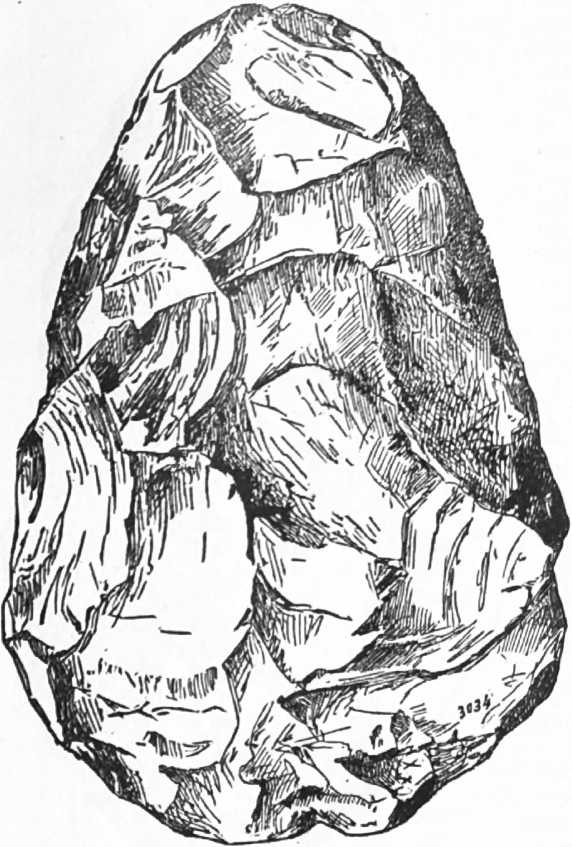
Any one living in the vicinity of any of the following streams can see for himself the terraces of which we are speaking, especially if he observes the valleys near where they emerge from the glaciated region; for the material which the water could push along was most abundant there. As one gets farther and farther away from the old ice margin the material composing the terraces becomes smaller, because more waterworn, and the terraces diminish in size. Favorable places in which to observe these glacial terraces are as follows: Little Beaver creek, Big Sandy creek, near Bayard, in Columbiana county; the Nimishillen, below Canton, and the Tuscarawas, below Navarre, in Stark county; Sugar creek, near Deardoff’s Mills, in Tuscarawas county; the Killbuck, below Millersburg, in Holmes county; the Mohican, near Gann, and Vernon river, near Millwood, in Knox county; the Licking river, below Newark, in Licking county; Rush creek, near Rushville, and the Hocking river, near Lancaster, in Fairfield county; Salt creek, near Adelphi, in Hocking county; the Scioto river, throughout its course, and Paint creek, near Bainbridge, in Ross county; and both the Miami rivers throughout their course. The Ohio river is also lined by these glacial terraces, which are from fifty to a hundred feet above present high-water mark. On the Ohio there are special enlargements of these terraces, where the tributaries enter it from the north, which come from the glaciated region as laid down on the map. This enlargement is noticeable below the mouth of the Muskingum in the angles of the river valley below Parkersburg, and in the vicinity of Portsmouth near the mouth of the Scioto, and at Cincinnati below the mouth of the Little Miami, and at Lawrenceburg, Indiana, below the mouth of the Great Miami. Below the mouth of the Muskingum the terrace is 100 feet above the flood plain of the river, and the highest part of the terrace on which old Cincinnati is built about the same height. Nearly all the cities along the Ohio are built on this glacial terrace.
The most interesting thing about these terraces, and what makes it proper for me in this connection to write thus fully about them, is that the earliest traces of man in the world are found in them. The accompanying cuts show two implements which were found in terraces such as I have been describing. The first was found at Abbeville, France, in such a terrace on the river Somme as those which occur in the valleys of Ohio. It was found in gravel that had never been disturbed, and so must have lain there ever since the glacial period, by whose floods it was buried, closed.
The second implement was found a few years ago, by Dr. Abbott in a similar gravel terrace, on which the city of Trenton, New Jersey, is built. This terrace was deposited by the Delaware river when it was swollen by glacial floods.
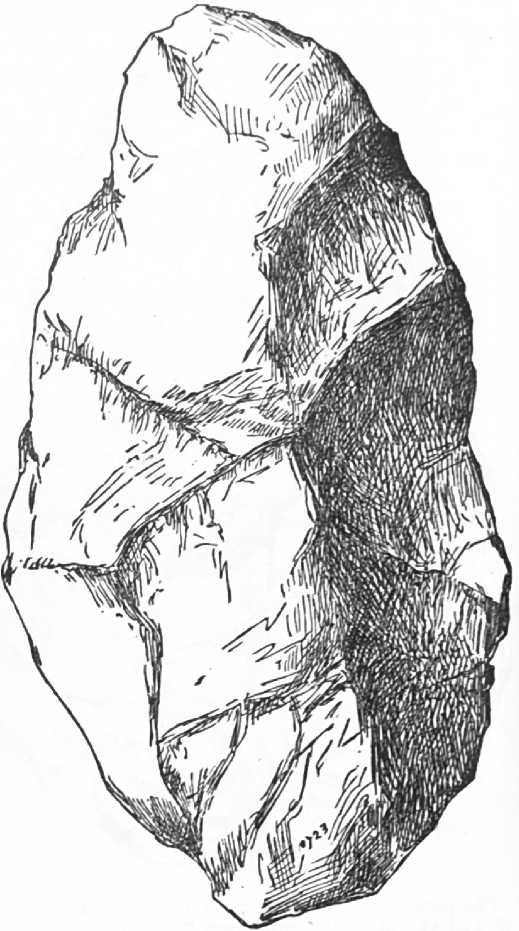
In my original “Report upon the Glacial Boundary of Ohio, Indiana and Kentucky,” I remarked that since man was in New Jersey before the close of the glacial period, it is also probable that he was on the banks of the Ohio at the same early period; and I asked that the extensive gravel terraces in the southern part of the State be carefully scanned by archaeologists, adding that when observers became familiar with the forms of these rude implements they would doubtless find them in abundance. As to the abundance, this prophecy has not been altogether fulfilled. But enough has been already discovered in Ohio to show that man was here at that early time when the ice of the glacial period lingered on the south side of the water partings between the lake and the Ohio river. Both at Loveland and at Madisonville, in the valley of the Little Miami, Dr. C. L. Metz, of the latter place, has found this ancient type of implements several feet below the surface of the glacial terraces bordering that stream. The one at Madisonville was found about eight feet below the surface, where the soil had not been disturbed, and it was in shape and appearance almost exactly like one of those found by Dr. Abbott in Trenton, N. J. These are enough to establish the fact that men, whose habits of life were much like the Eskimos, already followed up the retreating ice of the great glacial period when its front was in the latitude of Trenton and Cincinnati, as they now do when it has retreated to Greenland. Very likely the Eskimos are the descendants of that early race in Ohio.
In addition to the other conditions which were similar, it is found that the animals which roamed over this region were much like those which now are found in the far north. Bones of the walrus and the musk ox and the mastodon have been found in the vicinity of these implements of early man in New Jersey, and those of the mastodon were dug from the same gravel-pit in Loveland from which the implement found in that place was taken.
Having been able thus to associate our ancestors with the closing scenes of the glacial period, new interest at once attaches itself to glacial studies, and especially to glacial chronology. For if we can tell how long it is since the ice of the glacial period withdrew from the northern slope of the Ohio basin, we have done much towards settling the date of man’s appearance here. How then shall we determine the date of the close of the glacial period? This we cannot hope to do with great accuracy, but we can do something even here in Ohio towards the solution of that most interesting problem of man’s antiquity.
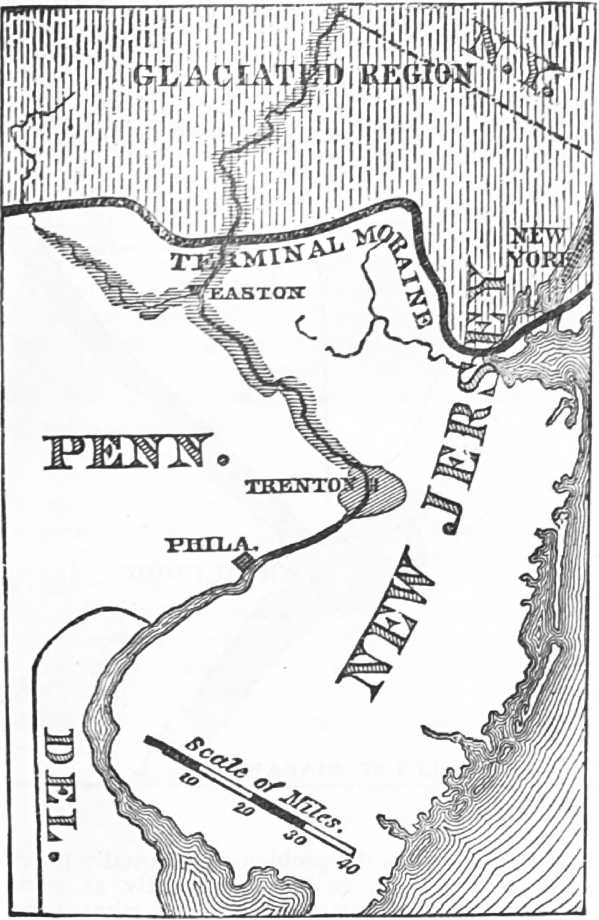
(1.) In the first place many streams are so situated that we can measure the work they have done since the glacial period, and also can form some idea of the rate at which they are at work. The gorge in Niagara river below the falls has long been a favorite place from which to get these measurements. This gorge is only about seven miles long—that being the distance from Queenston to the Falls. The gorge is throughout in limestone strata of pretty uniform hardness, and represents the work done by the river at that point since the glacial period. This we know from several signs. Before the glacial period Lake Erie did not exist In the long geological periods which had elapsed before the glacial age, a channel had been worn clear back from Lake Ontario to Lake Erie, as will be the case with the present river if only time enough is given it. In short, Lake Erie is only a glacial mill-pond. The old outlet was filled up by the glacial deposits which we have described so that the water had to seek a new outlet, which happened to be along the course of the present Niagara river. Confirmatory evidence of this is found at Cleveland and for many miles up the valley of the Cuyahoga river, as well as in many other streams of Northern Ohio. In boring for oil in the bed of the Cuyahoga a few years ago, it was found that the old rocky bottom is 200 feet below the present bottom of the river. This means that at one time Lake Erie was 200 feet lower than now. But the lake is for the most part less than 200 feet deep, so that if there were an outlet, as there must have been, at that lower level, the lake itself must have disappeared, and there was only a stream with a broad, fertile valley where the lake is now. Thus we prove that the Niagara gorge represents the work of erosion done by the river since the glacial period. The next problem is to ascertain how fast the river is wearing back the gorge.
That the gorge is receding is evident from the occasional reports heard of portions of the shelving rocks falling beneath the weight of water constantly pouring over them. If a continual dropping wear a stone, what must not such a torrent of water do? From measurements made between forty and fifty years ago and others repeated within the last few years, it has been ascertained that the falls are receding. The recent surveys of the government show that during the last forty-five years very nearly six acres of rock surface have broken off from the verge of the falls, making an average annual recession of about two and a half feet per year for the last forty-five years. Making allowances for portions of the work which had been done before the glacial period by smaller stream in the same channel, and for some other facts which there is not time here to mention, Mr. G. K. Gilbert, of the United States Geological Survey, concludes that the falls of Niagara cannot be more than 7,000 years old. This brings the glacial period much nearer than was formerly supposed.
But there are many things in our own State which go to confirm this calculation. The citizens of Ohio have not to go out of their own boundaries to find facts helping to solve the question of man’s antiquity. Nearly all the rivers emptying into Lake Erie have somewhere in their courses cataracts which can serve as chronometers of the glacial period. In the most of these cases it is possible to ascertain what part of the channel is pre-glacial and what post-glacial, and to form some estimate of the rate of recession. This can be done on the Chagrin, the Cuyahoga, Rocky, and Black rivers, and probably on some others. Let the young students of the State attack these problems before going abroad for great fields of discovery.
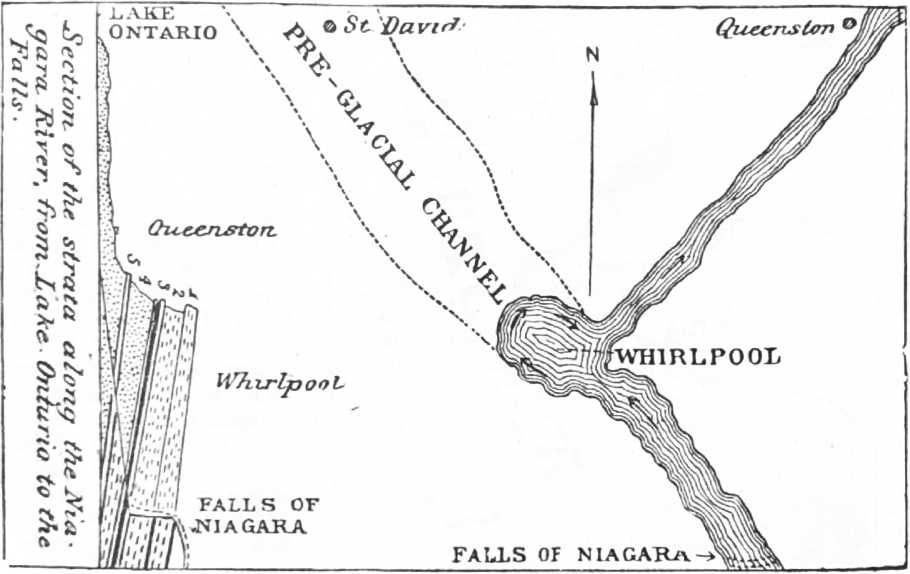
In the central and southern part of the State the problems are equally interesting. Since the glacial period the streams have been constantly at work enlarging their channels. How much have they enlarged them, and what is the rate of enlargement? These are definite problems appealing for solution on nearly all the tributaries of Ohio. Professor Hicks, of Granville College, set a good example in this line of investigation a few years ago. Raccoon creek, in Licking county, is bordered by terraces throughout its course. These are what we have described as glacial terraces, and are about fifty feet above the present flood plain of the stream. It is evident that at the close of the glacial period the valley was filled up to that level with pebbles and gravel, and that since that period the stream has been at work enlarging its channel until now it has removed gravel to the amount that would fill the valley up to the level of these terraces and across the whole space. Multiply this height, fifty feet, by the breadth from which the material has been removed, and that by the length of the stream, and make allowance for the diminution of the valley as the headwaters are approached, and you will have the cubical contents of the material removed by the stream since it began its work at the close of the glacial period. This is the dividend. Then find out how much mud and sand the stream is carrying out: this will be your divisor. It cannot be far from 10,000 years old. The result in the ease of Raccoon Creek was not materially different from the calculations concerning Niagara Falls. I have made a similar calculation concerning the age of Plum Creek in Oberlin, and the result is likewise to show that the glacial period cannot have been so long ago as was formerly supposed. If the glacial period closed much more than 8,000 or 10,000 years ago in Northern Ohio, the valleys of the post-glacial streams would be much larger than they really are. Again I say let the young investigators of the State attack the chronological problems offered by the streams in their own vicinity before sighing for other realms of science to conquer.
In conclusion, then, we may say it is not so startling a statement as it once was to speak of man as belonging to the glacial period. And with the recent discoveries of Dr. Metz, we may begin to speak of our own State as one of the earliest portions of the globe to become inhabited. Ages before the mound builders erected their complicated and stately structures in the valleys of the Licking, the Scioto, the Miami and the Ohio, man in a more primitive state had hunted and fished with rude implements in some portions at least of the southern part of the State.
To have lived in such a time, and to have successfully overcome the hardships of that climate and the fierceness of the animal life, must have called for an amount of physical energy and practical skill which few of this generation possess.
Let us not therefore speak of such a people as inferior. They must, therefore, have had all the native powers of humanity fully developed, and are worthy ancestors of succeeding races.
The recent discoveries of Dr. Metz, above alluded to by Prof. Wright, are described in full by an article communicated to me which will be found on page 20, Vol. II., of this work; also on page 48, Vol. II., some valuable facts from Wright’s “Ice Age in North America,” with a map of Lake Ohio, formed by a glacial dam at Cincinnati. This lake extended up the valley to beyond Pittsburgh, and occupied an area of 20,000 square miles, equal to half that of Ohio.
Under the head of “Palæolithic Man in Ohio,” Vol. III., page 365, is an article detailing a discovery of Mr. W. C. Mills, made in October, 1889, in the Tuscarawas Valley, identical with those of Dr. Metz in the Little Miami Valley.
—H. H.


